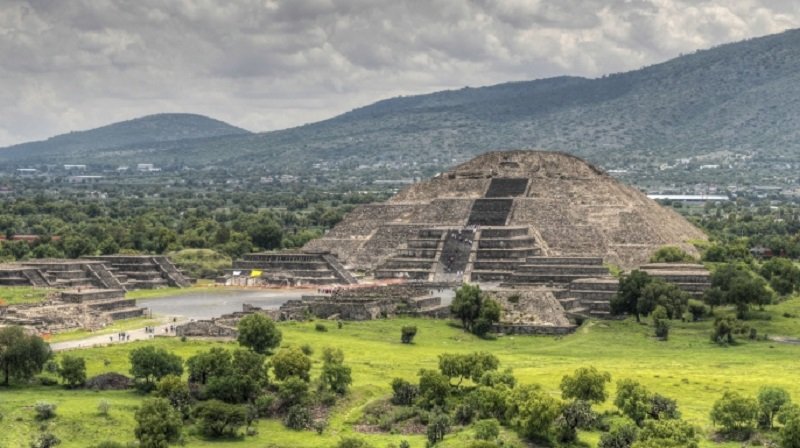
For centuries, archaeologists and other scholars have struggled to unlock the secrets of the ancient city of Teotihuacán. After reaching its peak just as the Roman Empire was in decline, the city was largely destroyed around A.D. 600 by fire and looting, perhaps as the result of a civil war or enemy invasion. By A.D. 750, the surviving members of Teotihuacán's population seem to have been absorbed into neighboring cultures, or to have abandoned the once-great city for their ancestral homelands.
Because they had no complex form of writing, relatively little is known about the founders and inhabitants of Teotihuacán. Archaeologists haven't discovered any carved slabs inscribed with characters, or any royal tombs. This lack of artifacts contrasts sharply with the wealth of evidence left behind by the Maya, who also built impressive pyramids in their cities in Central America.
It was the Aztecs who found the ruins of Teotihuacán in the 1300s and gave the city its name, which means "the place where men become gods" in Nahuatl. It was also the Aztecs who linked Teotihuacán's two largest pyramid—the Pyramid of the Sun and the Pyramid of the Moon—to their own story of creation. But according to Verónica Ortega, the Aztecs may have had the story wrong.
Ortega, an archaeologist with Mexico's National Institute of Anthropology and History, has been excavating the square surrounding Teotihuacán's Pyramid of the Moon in recent months. After finding canals and pool-like cavities located beneath the square, alongside statues of water gods, Ortega has concluded that the entire city was built as a sanctuary dedicated to the worship of water. "Water is the true protagonist of Teotihuacan," she told the Wall Street Journal. "If there was a city in the ancient world where water was worshipped, it was Teotihuacan."
Her theory draws support from previous excavations of Teotihuacán's other two pyramids, the Temple of the Sun and the smaller Temple of the Plumed Serpent, which revealed additional aquatic elements including seashells and water pitchers. At the same time, it challenges the popular hypothesis that the inhabitants of Teotihuacán, like other ancient Mesoamerican civilizations, worshipped various deities of equal stature, including several water gods and goddesses but also including the gods of fire and time.
There's no doubt that water would have been all-important for the people of Teotihuacán, most of whom were farmers. The climate was semi-arid, and no fewer than eight months out of the year could be dry. When the rainy season finally arrived, the Teotihuacanos would collect rainwater in canals and well to store and use on their crops; Ortega found four such canals running from the Temple of the Moon. She argues that though Teotihuacán did have other deities, including the god of fire, they played lesser roles than the gods of water. In fact, water and fire were closely linked, as both were produced by thunderstorms.
Based on her excavations, Ortega believes that the worship of water, including lakes, flooding and heavy rain, played a central role in the construction of the city. She disputes the traditional Aztec designation of the Temples of the Moon and Sun. According to Ortega, "The Pyramid of the Moon was actually consecrated to the goddess of rivers and lakes, Chalchuihtlicue in Aztec, while the god of storms, Tlaloc, was worshipped in the so-called Pyramid of the Sun."
To bolster her theory, Ortega points to a vivid mural found inside a palace in Teotihuacán, which depicts streams of water flowing from a pyramid-like structure. Painted in red and blue, it is believed to be an image of Tlalocan, the mythical paradise ruled by Tlaloc, a rain deity worshipped by the Aztecs and (apparently) the Teotihuacanos.
Other archaeologists praise Ortega's research but say she needs additional evidence to back up her theory. "This is an innovative, interesting proposal, but she has to demonstrate it properly," the local archaeologist Leonardo López Lújan told the WSJ: "To this day, I still think water was not the main ingredient present here, but also the gods of fire and time."



Does this dispel the stories of blood thirsty priests, ripping out the hearts of enemies while they are still alive, eating them and sucking there blood. Sounds like a B horror movie to me. How could a culture survive for what, a thousand or more years, and be socially organized if they were so degenerate.
Mind you, I guess there is a precedent in modern times, remember those reports and videos of liver eating "moderate rebels".
Thing is would those rebels be so "organized" without a "little help from there friends".